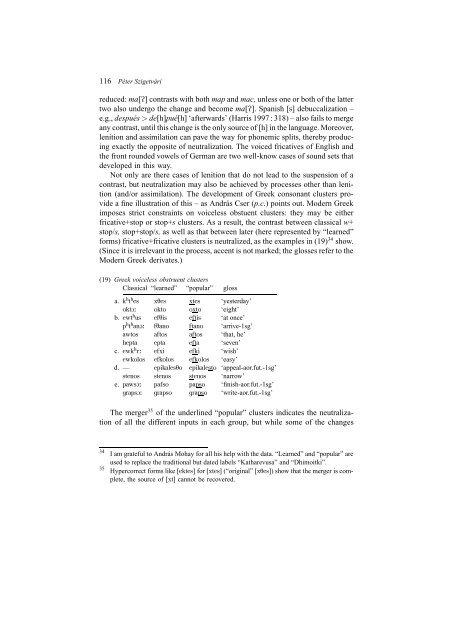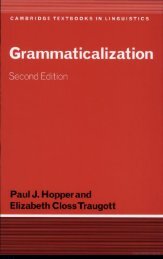What and where? Péter Szigetvári - SEAS
What and where? Péter Szigetvári - SEAS
What and where? Péter Szigetvári - SEAS
You also want an ePaper? Increase the reach of your titles
YUMPU automatically turns print PDFs into web optimized ePapers that Google loves.
116 <strong>Péter</strong> <strong>Szigetvári</strong><br />
reduced: ma[P] contrasts with both map <strong>and</strong> mac, unless one or both of the latter<br />
two also undergo the change <strong>and</strong> become ma[P]. Spanish [s] debuccalization –<br />
e.g., después > de[h]pué[h] ‘afterwards’ (Harris 1997 : 318) – also fails to merge<br />
any contrast, until this change is the only source of [h] in the language. Moreover,<br />
lenition <strong>and</strong> assimilation can pave the way for phonemic splits, thereby producing<br />
exactly the opposite of neutralization. The voiced fricatives of English <strong>and</strong><br />
the front rounded vowels of German are two well-know cases of sound sets that<br />
developed in this way.<br />
Not only are there cases of lenition that do not lead to the suspension of a<br />
contrast, but neutralization may also be achieved by processes other than lenition<br />
(<strong>and</strong>/or assimilation). The development of Greek consonant clusters provide<br />
a fine illustration of this – as András Cser (p.c.) points out. Modern Greek<br />
imposes strict constraints on voiceless obstuent clusters: they may be either<br />
fricative+stop or stop+s clusters. As a result, the contrast between classical w+<br />
stop/s, stop+stop/s, as well as that between later (here represented by “learned”<br />
forms) fricative+fricative clusters is neutralized, as the examples in (19) 34 show.<br />
(Since it is irrelevant in the process, accent is not marked; the glosses refer to the<br />
Modern Greek derivates.)<br />
(19) Greek voiceless obstruent clusters<br />
Classical “learned” “popular” gloss<br />
a. k h t h es xTes xtes ‘yesterday’<br />
oktO: okto oxto ‘eight’<br />
b. ewt h us efTis eftis ‘at once’<br />
p h t h anO: fTano ftano ‘arrive-1sg’<br />
awtos aftos aftos ‘that, he’<br />
hepta epta efta ‘seven’<br />
c. ewk h E: efxi efki ‘wish’<br />
ewkolos efkolos efkolos ‘easy’<br />
d. — epikalesTo epikalesto ‘appeal-aor.fut.-1sg’<br />
stenos stenos stenos ‘narrow’<br />
e. pawsO: pafso papso ‘finish-aor.fut.-1sg’<br />
grapsO: grapso grapso ‘write-aor.fut.-1sg’<br />
The merger 35 of the underlined “popular” clusters indicates the neutralization<br />
of all the different inputs in each group, but while some of the changes<br />
34<br />
I am grateful to András Mohay for all his help with the data. “Learned” <strong>and</strong> “popular” are<br />
used to replace the traditional but dated labels “Katharevusa” <strong>and</strong> “Dhimoitki”.<br />
35<br />
Hypercorrect forms like [ektes] for [xtes] (“original” [xTes]) show that the merger is complete,<br />
the source of [xt] cannot be recovered.
















